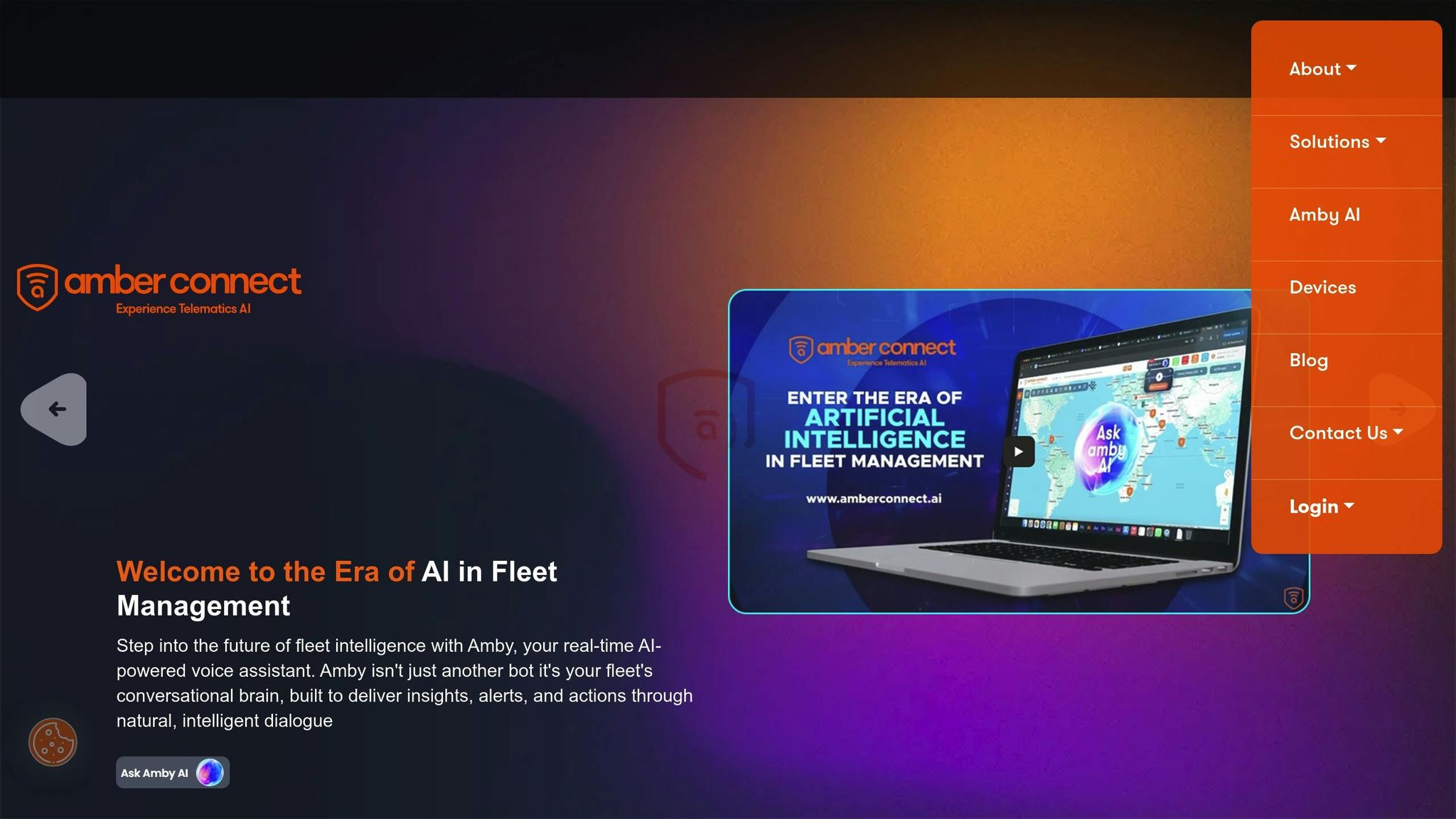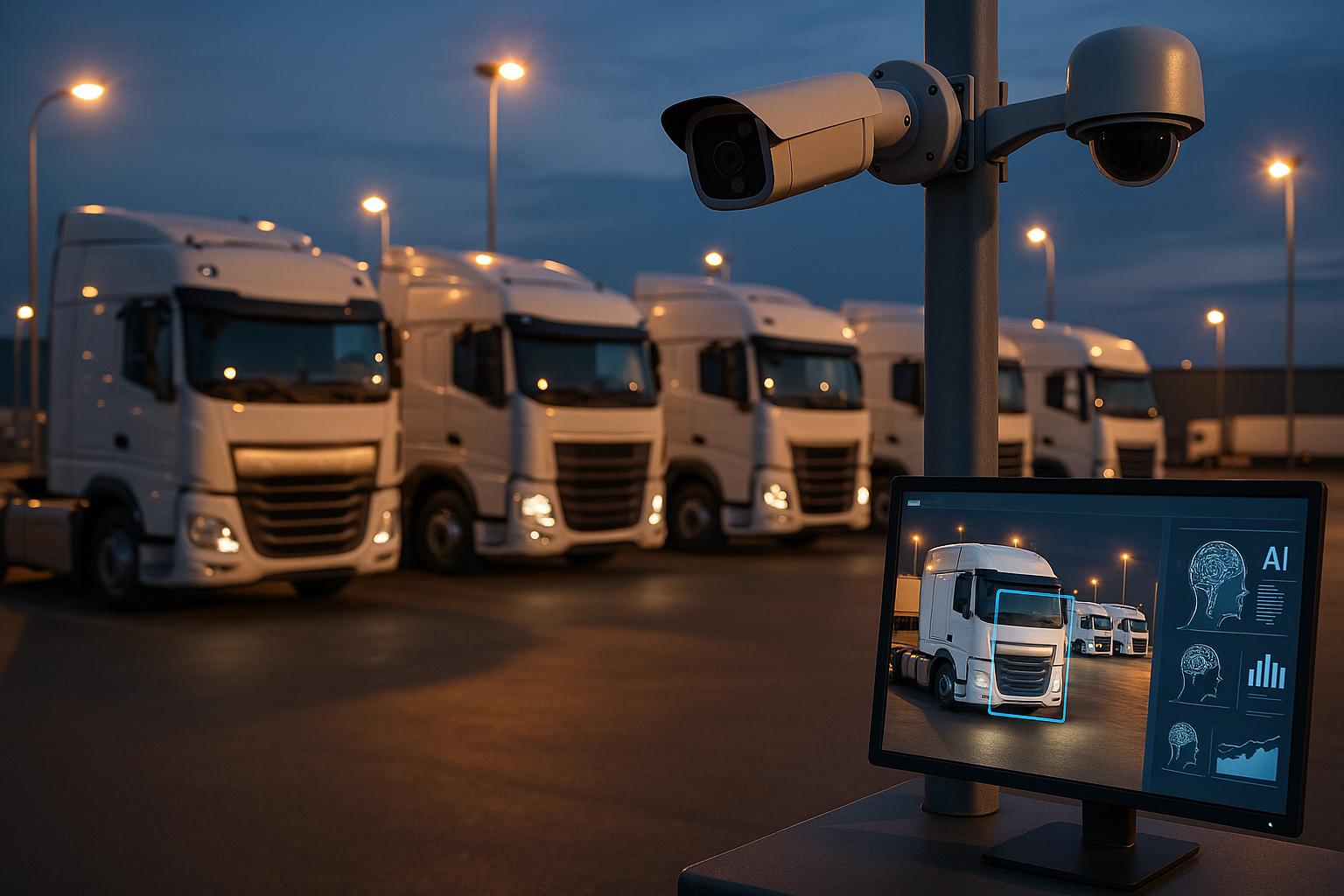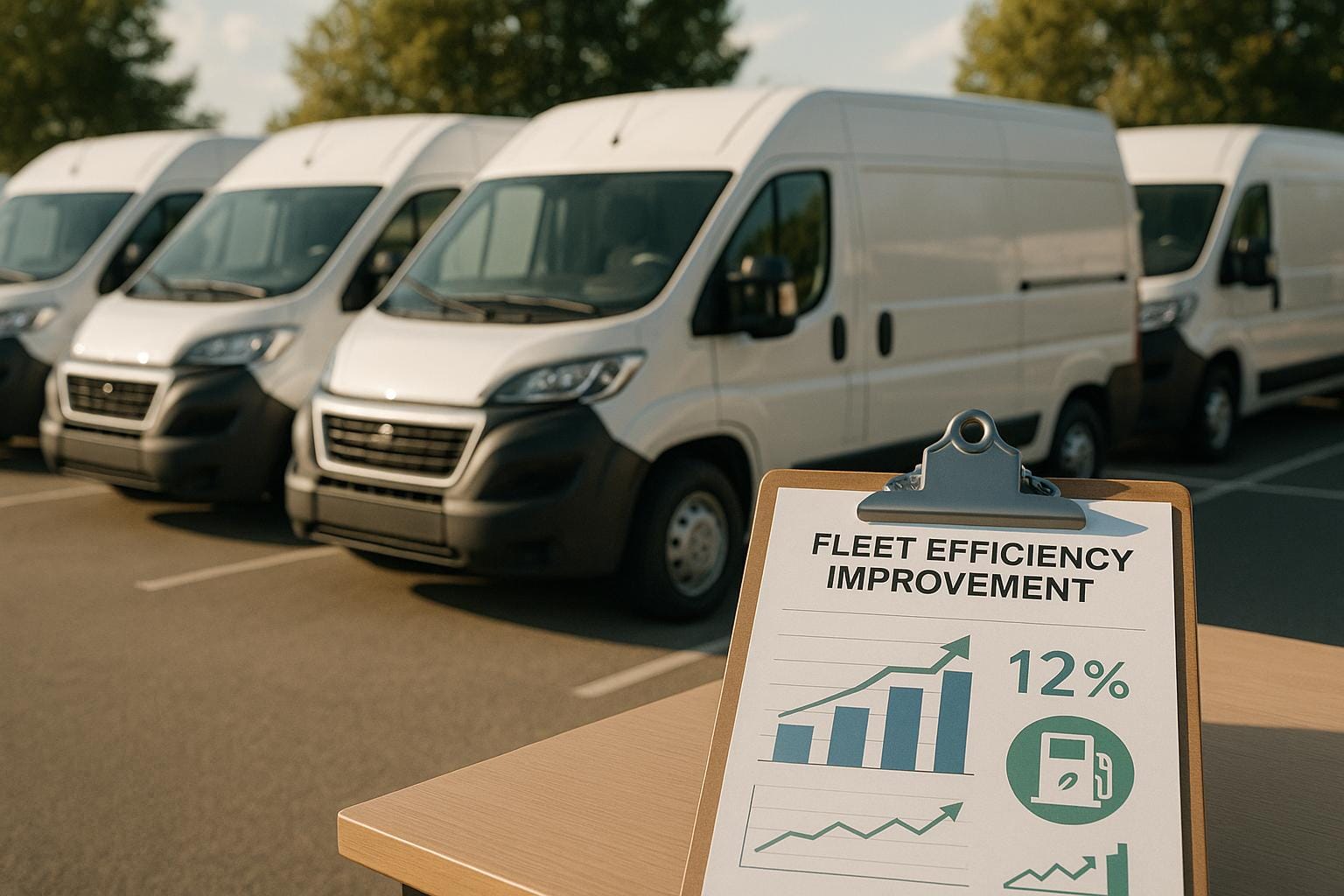Fleet theft is a growing problem in the UK, costing businesses millions annually. AI algorithms are now stepping in to address this issue by providing smarter, faster, and more reliable security solutions compared to outdated methods like locks and manual monitoring. Here’s how AI is reshaping fleet security:
- 24/7 Monitoring: AI systems analyse data in real-time, flagging unusual activity such as tampering or unexpected movements.
- Predictive Risk Analysis: Using historical data, AI predicts theft risks before incidents occur, allowing fleet managers to act early.
- Automated Responses: Immediate alerts and remote vehicle immobilisation ensure quick action when a threat arises.
- Higher Recovery Rates: AI-powered tracking and location prediction tools help recover stolen vehicles faster, often in hours instead of months.
- Smart Cameras: AI-equipped cameras reduce false alarms by up to 90%, focusing on genuine threats like suspicious behaviour or unauthorised access.
- Geofencing and GPS Integration: Virtual boundaries and advanced tracking ensure vehicles stay within designated zones, with alerts triggered if they don’t.
With theft rates rising and criminals using advanced tactics, AI-driven solutions like GRS Fleet Telematics are helping UK businesses protect their assets. These systems offer features such as dual trackers, remote immobilisation, and predictive analytics for as little as £7.99 per vehicle per month. By combining these tools, businesses can minimise losses, improve recovery rates, and stay ahead of theft risks.
Amber Connect: The Ultimate AI-Powered Vehicle Security App for Total Peace of Mind! 🚘🔒

How AI Algorithms Solve Fleet Theft Problems
AI takes traditional fleet monitoring to the next level by predicting and addressing theft risks through advanced data analysis and pattern recognition. These systems process massive amounts of data in real time, creating benchmarks for normal operations and flagging unusual activity that might indicate theft. This proactive approach helps identify threats before they develop into full-blown incidents. Below, we’ll explore how AI enhances real-time threat detection, predictive risk analysis, and automated responses.
AI-powered solutions are proving highly effective. Research shows that 19% of fleet expenses are lost to fraud or theft, highlighting the scale of the problem these systems aim to solve.
Live Monitoring and Threat Detection
AI monitoring systems work 24/7, analysing multiple data streams simultaneously to spot unusual behaviour. For example, AI-equipped cameras can detect tampering with vehicles or unauthorised access while parked. Features like facial recognition and number plate detection add another layer of security by verifying user authorisation in real time.
In practice, these technologies have delivered impressive results. One logistics firm, for instance, used AI to block over 2,000 suspicious transactions, saving approximately £850,000 in 2024. Such examples demonstrate how AI can significantly cut costs by preventing theft.
Predicting Theft Risks Before They Happen
AI doesn’t just react to threats - it predicts them. Machine learning algorithms analyse historical data, location trends, and timing to spot patterns that suggest a heightened risk of theft. This allows fleet managers to act preemptively, rather than waiting until after an incident occurs.
The benefits of predictive AI aren’t limited to fleet management. For example, banks have used similar tools to reduce false alarms about suspicious activity by up to 50%. The Royal Bank of Scotland reported saving over £7 million during an AI pilot programme that flagged fake invoices in small business transactions.
Automatic Alerts and Response Systems
When a threat is detected, AI systems send immediate alerts to managers and law enforcement, enabling a swift response. This quick action marks a significant improvement over older security methods, ensuring that genuine threats are handled efficiently without bogging down operations with false positives.
The financial benefits are clear. One study revealed that AI fraud detection systems prevented over 80,000 unauthorised transactions, saving around £42.5 million. In another instance, after a major fraud event in 2018, a company that adopted an AI-driven solution saved approximately £131,000 and halved the number of unidentified drivers almost instantly.
These examples underline how AI is reshaping fleet security. By matching the sophistication of modern theft tactics with equally advanced defences, AI has become a critical tool for safeguarding fleet assets in today's increasingly complex security landscape.
AI-Powered Fleet Security Technologies
Modern fleet security has taken a leap forward with AI-driven solutions, combining smart cameras, location tracking, and behavioural analysis to tackle theft in increasingly advanced ways. These technologies work together to create a multi-layered defence system, adapting to the constantly evolving tactics of thieves. Here's how each piece of technology plays a role in safeguarding fleets.
Smart Cameras and Driver Behaviour Analysis
AI-powered cameras are a major step up from traditional CCTV systems. Equipped with computer vision and machine learning, these cameras analyse video feeds in real time, distinguishing between harmless activity and potential threats. For example, they can spot suspicious behaviours like loitering near vehicles, attempts to avoid camera detection, or unauthorised access to restricted areas, often using facial recognition software.
What sets these cameras apart is their ability to act instantly. They can integrate with existing security systems, triggering automatic actions like locking doors, activating additional cameras, or alerting security teams when a threat is detected. This eliminates the delays that come with manual monitoring.
Another key advantage is their impact on reducing false alarms. AI cameras can cut false alarms by up to 90%. For instance, a major retail chain managed to lower its monthly false alarms from 200 to just 10 after switching to smart cameras. This allows security teams to focus their efforts on real issues rather than wasting time on false positives.
Digital Boundaries and Number Plate Recognition
Geofencing technology creates virtual boundaries around specific areas, sending alerts the moment these perimeters are breached. With AI integration, these systems gain contextual awareness, allowing fleet managers to set up customised alerts for events like after-hours vehicle movement, door openings, or engine starts.
Automatic number plate recognition (ANPR) adds another layer to fleet security. By tracking vehicle movements and cross-referencing number plates with databases of stolen vehicles, ANPR systems can instantly flag unauthorised activity. This is especially useful at entry and exit points, ensuring that only authorised vehicles access fleet premises.
Combining geofencing with ANPR creates a highly effective defence. For instance, if a vehicle exits its designated zone, the system can instantly verify whether the movement is authorised by checking the time, location, and driver credentials. If not, alerts are triggered, allowing for immediate action. GPS and telematics integration further strengthen these measures, adding another layer of protection.
GPS and Telematics System Integration
Integrating AI with GPS and telematics systems provides a comprehensive approach to vehicle monitoring and theft prevention. AI enhances GPS tracking by analysing historical data and environmental factors, improving accuracy and reliability.
This integration proves invaluable in real-world scenarios. For example, a landscaping company used AI-enhanced GPS tracking to detect a trailer leaving its geofenced area. The manager received an alert, reviewed a live feed, and contacted law enforcement, leading to a quick recovery.
Real-time tracking ensures vehicles and equipment remain visible at all times. Even if a tracking device is disabled, the last known location is stored, aiding recovery efforts. Some systems also allow for remote engine shutdown, preventing thieves from escaping with stolen assets.
Vehicles equipped with GPS trackers are far more likely to be recovered. This is a critical advantage, especially in the UK, where only about 5% of unregistered plant equipment is ever recovered. By combining AI with GPS tracking, fleet managers gain a powerful tool to protect their assets from increasingly sophisticated theft attempts.
AI Methods for Recovering Stolen Vehicles
AI isn't just helping to prevent vehicle theft - it’s also becoming a key tool in recovering stolen vehicles. When a vehicle is stolen, every second matters. Thanks to AI-driven recovery systems, fleet operators and law enforcement can now track stolen vehicles and even predict their likely destinations based on movement patterns. This turns the recovery process into a faster, data-driven operation.
Live Tracking and Location Prediction
AI-powered algorithms go beyond basic GPS tracking by analysing data from GPS, telematics, and IoT devices to uncover patterns that might otherwise be missed. These systems add a layer of context, sending alerts when a vehicle enters a high-risk area or takes an unusual route late at night. Machine learning models also use historical data to predict the most likely routes a stolen vehicle might take.
With these predictive tools, recovery teams can act quickly, intercepting vehicles based on their anticipated movements. AI also leverages computer vision to identify key details like vehicle type, colour, and number plates, ensuring stolen vehicles are recognised promptly. By integrating with live mapping tools, these systems provide real-time tracking, enabling swift responses to unexpected developments. Additionally, AI can detect unusual usage patterns - such as engine activity during off-hours or signs of forced entry - and immediately alert fleet managers or security teams.
One logistics company showcased the power of AI-driven predictive analytics by optimising delivery routes based on traffic and weather data. This led to a 25% reduction in both delivery times and fuel costs. These predictive capabilities underline AI's ability to enable rapid, remote interventions.
Remote Vehicle Shutdown and Recovery Help
AI doesn’t stop at tracking - it also enables remote interventions to secure stolen vehicles. Using a feature called "safe stop", fleet managers can remotely disable a vehicle while providing its exact location to recovery teams. This technology can significantly cut down the time it takes to recover stolen cargo, often reducing recovery times from months to just a few hours.
Remote engine immobilisation is another powerful tool, halting a vehicle's movement and preventing thieves from escaping. At the same time, recovery teams receive real-time updates on the vehicle’s location. The integration of GPS tracking with these shutdown capabilities has revolutionised the recovery process, making it both faster and more reliable. By combining these tools, AI not only enhances recovery times but also strengthens overall fleet security.
Higher Recovery Rates with AI Technology
The numbers paint a stark picture: cargo theft has surged by 1,500% since 2021, costing the industry an estimated £27 billion annually. In 2022 alone, 130,389 vehicles were stolen in the UK, while the US saw over 1 million vehicle thefts. AI addresses these challenges by detecting subtle patterns that reduce false alarms and improve the accuracy of threat detection. Unlike traditional methods, which often react after the fact, AI enables proactive monitoring and immediate alerts, ensuring faster responses to incidents.
"AI has become a game-changer in loss prevention by enhancing the accuracy, efficiency, and scalability of traditional methods."
GRS Fleet Telematics: AI-Powered Theft Prevention and Recovery
With vehicle theft on the rise, UK businesses need more than just traditional security measures to safeguard their fleets. GRS Fleet Telematics offers a cutting-edge solution by combining advanced AI technology with dual-tracker systems to provide robust protection.
GRS Fleet Telematics Security Features
At the heart of GRS Fleet Telematics is its dual-tracker system. Each vehicle is equipped with a primary tracker and a backup device, ensuring continuous monitoring even if one tracker is compromised. This redundancy makes it far harder for criminals to evade detection.
The system includes real-time GPS tracking, allowing fleet managers to monitor vehicle locations continuously. Alerts are automatically triggered via SMS, email, or app notifications whenever suspicious activity is detected - such as unauthorised movement during off-hours or entry into high-risk areas.
One standout feature is remote immobilisation, which lets fleet managers disable a stolen vehicle remotely. This not only halts the vehicle’s movement but also provides precise location data to recovery teams, significantly reducing the time between detection and recovery.
To further enhance security, GRS Fleet Telematics offers 24/7 monitoring support. Professional surveillance teams are always on hand to assist with incidents, working closely with law enforcement to ensure swift and effective recovery.
AI Technology in GRS Systems
Beyond its hardware, GRS Fleet Telematics leverages advanced AI to strengthen security. By analysing normal driver behaviour, the system can detect unusual activities like unauthorised access or tampering attempts.
Machine learning enables the system to distinguish between legitimate vehicle use and potential theft. For instance, it can flag instances where a vehicle is accessed outside regular working hours or when driving patterns deviate from established routes. Upon detecting suspicious behaviour, the system sends instant alerts and can even immobilise the vehicle remotely to prevent further movement.
The system also uses predictive analytics to assess theft risks. By analysing historical data alongside real-time information, it identifies vehicles at higher risk based on factors such as location and time of day.
Additionally, facial and number plate recognition technology adds another layer of security by identifying unauthorised individuals attempting to access vehicles.
These integrated features not only boost security but also provide economic benefits for fleet operators.
Cost-Effective Fleet Protection
GRS Fleet Telematics delivers high-level protection at a price point that suits businesses of all sizes. Plans start at just £7.99 per vehicle per month, making advanced AI-driven security accessible to any fleet.
The system offers flexible hardware options to cater to different needs:
- The Essential package (£35) provides basic single wired tracking.
- The Enhanced package (£79) includes dual-tracker technology.
- The Ultimate package (£99) adds vehicle immobilisation capabilities.
With a 91% recovery rate for stolen vehicles and a 30% reduction in theft incidents reported by fleets using AI-based systems in the UK, the effectiveness of GRS Fleet Telematics is clear.
Additional perks include free installation when paired with GRS Fleet Graphics branding services and a pay-per-recovery model, which ensures businesses only pay when recovery efforts are successful.
The Future of AI in Fleet Theft Prevention
Fleet security is undergoing a transformation as AI continues to push the boundaries of theft prevention. With criminals becoming more tech-savvy, fleet operators need to stay one step ahead by adopting cutting-edge solutions. The next wave of AI technology promises deeper integration and a proactive approach to tackling threats.
Future AI-powered cameras are set to combine real-time facial recognition, number plate scanning, and cargo monitoring, creating a robust security network capable of identifying risks before they escalate. Eric Frey, director of global product management at Powerfleet, emphasises the importance of this shift, noting that "AI-enabled cameras [are] leading the way".
The transition from reactive to predictive security measures marks a significant leap forward for fleet protection. Advanced AI systems will analyse massive datasets to spot patterns and anomalies that could indicate theft or fraud. This predictive capability will allow fleet managers to act preemptively, stopping incidents before they occur.
AI will also play a key role in route planning and risk management. With AI-driven route optimisation and IoT sensors, vehicles can avoid high-risk areas and detect subtle issues that might otherwise go unnoticed. These systems not only reduce the likelihood of theft but also improve efficiency by cutting fuel costs and minimising breakdowns.
Telematics systems equipped with advanced IoT sensors are already monitoring intricate details like vibrations that signal early wear and tear on components such as bearings. By identifying these issues early, operators can address them before they lead to costly failures.
Predictive maintenance, another AI-driven feature, will further bolster theft prevention by ensuring vehicles remain in top condition. Unplanned breakdowns, which increase vulnerability to opportunistic theft, can be reduced by 47% with these systems, keeping fleets operational and secure.
Jane Jazrawy, CEO of CarriersEdge, highlights the stakes involved: "The thieves are making good use of technology in how they're committing the crime of cargo theft, so it stands to reason that carriers use technology to fight it". This ongoing technological tug-of-war means that operators who fail to adopt AI-powered solutions risk falling behind in both security and efficiency.
For fleet operators in the UK, the takeaway is clear: embracing AI-powered tracking technologies is no longer optional - it’s essential. Systems like GRS Fleet Telematics, which already feature AI-driven threat detection and dual-tracker technology, set a high benchmark for fleet security. With real-time tracking reducing theft and loss by 72% and increasing asset utilisation by 70%, the benefits of AI for fleet security are undeniable.
The future belongs to fleets that blend human expertise with AI to create adaptive, evolving security systems capable of meeting the challenges of tomorrow.
FAQs
How does AI predictive risk analysis enhance fleet vehicle security compared to traditional methods?
AI-driven predictive risk analysis is changing the way fleet security is managed. Instead of waiting to respond after an incident occurs, this technology analyses data patterns to anticipate risks, allowing fleet operators to act before problems arise. Whether it’s theft, damage, or other threats, AI enables proactive strategies to minimise these issues.
This shift doesn't just enhance safety - it also helps cut costs by reducing downtime and preventing losses. By processing vast amounts of data with speed and precision, AI gives fleet operators a reliable way to stay ahead of potential risks and safeguard their vehicles more effectively.
What technologies are used in AI-driven fleet security systems to prevent theft and aid recovery?
AI-powered fleet security systems bring together advanced technologies to protect vehicles and enable quick recovery in the event of theft. These systems often include GPS tracking, which provides real-time updates on a vehicle's location, and geofencing alerts that notify operators when a vehicle moves beyond designated boundaries. They also feature remote immobilisation, allowing vehicles to be disabled remotely if unauthorised access is detected.
Many systems also incorporate AI-enhanced dash cameras to monitor activity and flag suspicious behaviour. On top of that, they use behavioural data analysis to spot unusual patterns that could signal potential theft risks. Combined, these tools offer a thorough and proactive solution for safeguarding fleets.
Are AI-driven fleet security solutions, like those from GRS Fleet Telematics, affordable for small and medium-sized businesses in the UK?
AI-driven fleet security solutions, like those from GRS Fleet Telematics, are tailored to meet the needs of small to medium-sized businesses in the UK. Starting at just £7.99 per month, these systems offer advanced features, including dual-tracker technology, and boast an impressive 91% recovery rate for stolen vehicles.
By choosing AI-powered fleet security, businesses can improve vehicle safety while cutting down on operational risks and expenses. It's a practical way to safeguard assets without stretching the budget.




